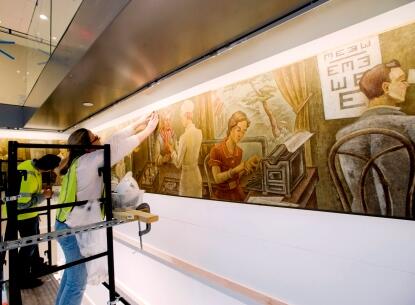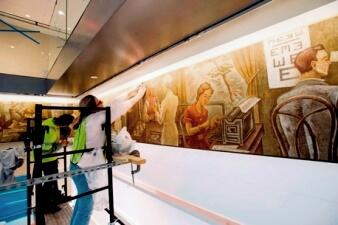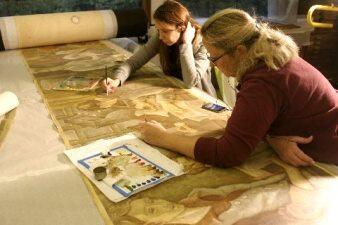
March 8, 2013
Restored Medical Murals Featured in McGlothlin Building
Share this story
Rick Vogt is locked in a meticulous cycle as he climbs down from a ladder, steps back to examine his work and climbs back up for slight adjustments.
It’s Feb. 25, and he’s working in the ground floor atrium of Virginia Commonwealth University’s almost completed 12-story, 200,000-square-foot James W. and Frances G. McGlothlin Medical Education Center. Saws still hum and hardhats are required, but the building is almost complete.
Vogt is a conservator hired to oversee the restoration and mounting of more than 100 feet of 70-year-old murals. He is overseeing the final steps of his multiyear project, and he’s pleased with the results.
“There’s so much more color now,” he says. “They’re so much brighter.”
When mounted, these murals will welcome faculty, staff and students into one of the most state-of-the-art medical education centers in the country. The center will feature 25,000 square feet of simulation space on two floors, 50,000 gross square feet dedicated to cancer research and four large studios designed for group learning. It’s all part of a novel medical curriculum that bypasses traditional barriers between academic disciplines to prepare graduates for real-world multidisciplinary hospital environments.
The curriculum allows medical students to learn alongside nursing, pharmacy and physical therapy students, among others, which is a unique concept on its own, but also included in the curriculum are elements of theater designed to improve skills like bedside manner.

On this same plot of land, more than 70 years ago, George Murrill spent many deliberate days of his own in front of the canvas.
Murrill, a Richmonder who had just graduated from art school at Yale University, was hired in the fall of 1937 as an artist-in-residence by Dr. William T. Sanger, president of the Medical College of Virginia from 1925 to 1956.
When Murrill was finished, his murals would provide aesthetic comfort in the waiting rooms of the nine-story MCV Outpatient Clinic (later named the A.D. Williams Clinic after the chief benefactor’s death).
The clinic would feature four floors each of outpatient clinics and labs with one floor for MCV administrative purposes. It was a major upgrade from the medical college’s former outpatient clinic – an antebellum house. The clinic, which was under construction when Murrill began his work, opened in January of 1938.
“Back then, the medical school stood alone and Dr. Sanger wanted his students to have well-rounded exposure,” said Jodi Koste, archivist and head of resources and operations, VCU Tomkins-McCaw Library. “He thought that if the students saw [Murrill] at work it would aid them as they became health care practitioners.”
In addition to exposing medical students to cultural ideas and pursuits beyond medicine, Sanger wanted the murals to provide a glimpse into the history of the institution, which opened its doors almost 100 years earlier in 1838.
Murrill worked in charcoal and later colorized the more than 100 feet of canvas, which would eventually depict images of the MCV physicians, nurses, patients and medical equipment of both the 19th Century and the 1930s and 1940s.
Murrill first worked on the murals from 1937 to 1941, postponing the piece when he enlisted in the armed forces after the Dec. 7, 1941, attack on Pearl Harbor. Upon his return, Murrill went to work for a Newport News dry dock and shipbuilder, making sporadic trips to Richmond to finish the murals for the clinic. They were completed in 1947.

Vogt remains watchful and stresses perfection through the mounting process to the trim work.
Today is the meticulous cap to a painstaking process.
Vogt has worked intermittently since 2010 restoring, preserving and mounting the art. He removed the murals from the waiting rooms of A.D. Williams Clinic in May 2010 before the building’s demolition and formed an all-star team to ensure all aspects of the project were done properly.
Susan Buck, Ph.D., a paint chemist, was in charge of the microscopic paint imaging that determined the types of paints, original colors, overcoat materials and even cleaning agents used throughout the years.
“The cleaning agents were the biggest problem,” Vogt says. “More than the pollutants from people smoking and other things.”
David Olin of Olin Studios in Northern Virginia used Buck’s findings to determine the least intrusive method for cleaning the murals. After cleaning, Olin stabilized the existing paint, consolidated losses in the canvas, applied new paint where paint loss had occurred and then sealed it all.
“Reversibility was an important component of this process,” Vogt says. “We needed to make sure not to permanently alter anything that was original.”
Also salvaged from the A.D. Williams Clinic were two 14-inch bronze clocks that adorned the front of the murals. Vogt handled the clocks’ cleaning and restoration. They retain their original guise, but were sent away to become digitally synched with the other time keepers in the building.
These clocks will return to new walls, but to their original perches on the mural canvases – canvases that were commissioned to break down disciplinary silos that were just as easily erected around medical education in 1937 as in 2013.
Appropriately, those new walls represent a lasting endeavor by the VCU School of Medicine to continue reaching across and outside the medical field to ensure its students have access to uniquely effective ideas and strategies for treating and healing people.
Subscribe to the weekly VCU News email newsletter at http://newsletter.news.vcu.edu/ and receive a selection of stories, videos, photos, news clips and event listings in your inbox every Thursday.
Subscribe to VCU News
Subscribe to VCU News at newsletter.vcu.edu and receive a selection of stories, videos, photos, news clips and event listings in your inbox.









